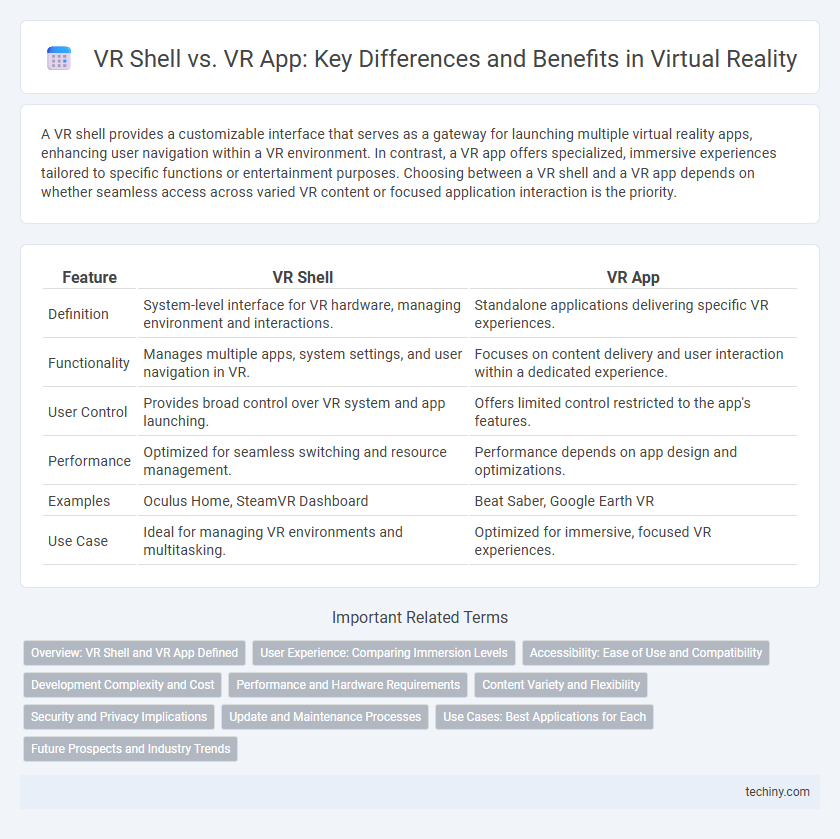A VR shell provides a customizable interface that serves as a gateway for launching multiple virtual reality apps, enhancing user navigation within a VR environment. In contrast, a VR app offers specialized, immersive experiences tailored to specific functions or entertainment purposes. Choosing between a VR shell and a VR app depends on whether seamless access across varied VR content or focused application interaction is the priority.
Table of Comparison
| Feature | VR Shell | VR App |
|---|---|---|
| Definition | System-level interface for VR hardware, managing environment and interactions. | Standalone applications delivering specific VR experiences. |
| Functionality | Manages multiple apps, system settings, and user navigation in VR. | Focuses on content delivery and user interaction within a dedicated experience. |
| User Control | Provides broad control over VR system and app launching. | Offers limited control restricted to the app's features. |
| Performance | Optimized for seamless switching and resource management. | Performance depends on app design and optimizations. |
| Examples | Oculus Home, SteamVR Dashboard | Beat Saber, Google Earth VR |
| Use Case | Ideal for managing VR environments and multitasking. | Optimized for immersive, focused VR experiences. |
Overview: VR Shell and VR App Defined
VR Shell functions as the immersive operating environment that manages and displays virtual reality content, providing a seamless user interface and navigation within the VR ecosystem. VR Apps are individual software applications developed to run within the VR Shell, offering specialized experiences such as gaming, education, or simulation. Together, VR Shell and VR Apps create a structured framework where the Shell acts as the platform and the Apps serve as interactive content modules enhancing user engagement.
User Experience: Comparing Immersion Levels
VR Shell offers a consistent user interface that enhances immersion by minimizing distractions and providing seamless transitions between virtual environments. In contrast, VR Apps deliver tailored experiences with specialized content but may vary in immersion quality due to differing design standards and performance capabilities. Users often find VR Shell environments more stable and accessible, while VR Apps excel in customized, interactive storytelling and functionality.
Accessibility: Ease of Use and Compatibility
VR Shells provide a more accessible entry point for users by offering a unified interface compatible across multiple VR devices, reducing the need for separate installations. VR Apps often require specific hardware capabilities and operating system versions, which can limit compatibility and increase setup complexity. Streamlined VR Shell platforms enhance ease of use, enabling broader adoption through consistent user experiences and seamless device integration.
Development Complexity and Cost
VR shells simplify development by providing a pre-built framework that reduces coding effort and accelerates project timelines, significantly lowering costs compared to custom VR app creation. Building a VR app from scratch allows for tailored user experiences and advanced features but demands extensive resources, specialized skills, and higher budgets. Companies often choose VR shells to balance functionality and affordability when rapid deployment is a priority.
Performance and Hardware Requirements
VR Shell offers streamlined performance by operating as a lightweight interface that manages VR environments with minimal hardware strain, ideal for devices with limited processing power. In contrast, VR Apps require more extensive hardware resources due to standalone functionality and complex graphics rendering, which can impact frame rates and responsiveness. Optimizing for VR Shell can extend battery life and reduce latency, whereas VR Apps demand higher GPU and CPU capabilities to maintain immersive experiences.
Content Variety and Flexibility
VR Shells offer extensive content variety by supporting multiple VR apps and experiences within a unified interface, enabling seamless switching between games, educational modules, and simulations. VR apps, on the other hand, provide specialized and highly optimized content tailored to specific use cases but often lack the flexibility to integrate diverse experiences. This distinction highlights VR Shells' advantage in delivering broad content access while VR apps excel in focused, immersive experiences.
Security and Privacy Implications
VR Shells act as secure environments that manage multiple VR apps under consistent privacy policies, reducing risks of data leakage by isolating each app's access to sensitive user data. In contrast, individual VR apps often have varied security protocols, increasing vulnerability to unauthorized data collection and privacy breaches. Centralized control in VR Shells enhances user trust by enforcing standardized permissions and minimizing exposure to malware compared to standalone VR applications.
Update and Maintenance Processes
VR Shells offer streamlined update and maintenance processes by centralizing software management, enabling automatic system-wide enhancements and security patches without disrupting user experience. VR Apps require individual updates through app stores, often leading to fragmented maintenance schedules and potential compatibility issues with the VR hardware. Efficient VR Shell management reduces downtime and ensures consistent performance across multiple applications within the virtual reality ecosystem.
Use Cases: Best Applications for Each
VR Shells excel in immersive training simulations and virtual tours by providing a comprehensive, controlled environment tailored for industries like healthcare and architecture. VR Apps are best suited for gaming, social interaction, and fitness, offering customizable experiences that run on various devices with easier updates. Enterprises leverage VR Shells for large-scale deployments, while individual users prefer VR Apps for personalized entertainment and productivity.
Future Prospects and Industry Trends
VR Shells offer immersive, hardware-integrated environments that streamline user interaction and enhance sensory feedback, positioning them as pivotal in the future of seamless VR experiences. VR Apps continue to evolve with cloud streaming and AI-driven personalization, enabling scalable content delivery and adaptive user interfaces across diverse devices. Industry trends indicate a convergence of VR Shells and Apps, promoting hybrid platforms that leverage high-performance processing and flexible software ecosystems for enterprise, gaming, and education sectors.
VR Shell vs VR App Infographic

 techiny.com
techiny.com